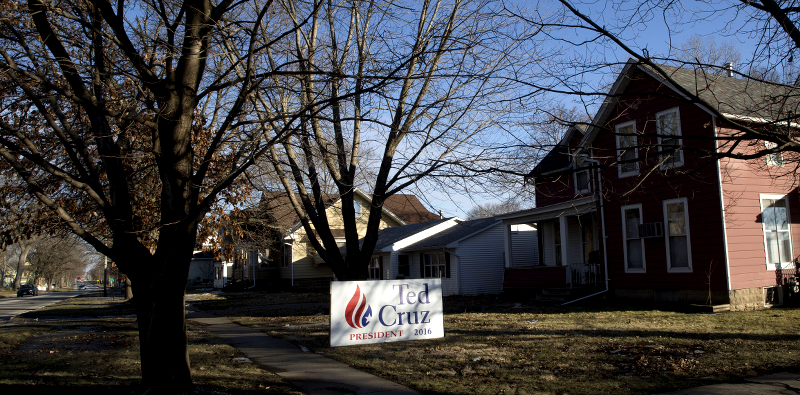Hello, I'm Will Jordan and welcome to The Pulse.
The Pulse is a weekly newsletter YouGov has launched ahead of the 2016 primaries and general election to give readers a one-stop-shop for the latest polling-related news from the campaign.
In addition to YouGov’s own extensive coverage of the election, The Pulse gives you the five things you need to know about the state of the campaign each week (and one you don't need to know but we think is worth knowing anyway!).
This week the focus is Iowa, Iowa, Iowa. The caucuses for both parties take place next Monday, and here are some questions to keep in mind on the night.
- Who is leading in the polls?
This isn't acutally so much something to watch out for as something to keep in mind. In the final poll by rockstar Iowa pollster (if there could ever be such a thing) Ann Selzer for Bloomberg Politics and the Des Moines Register finds Donald Trump leading Ted Cruz by five points, 28% to 23%, with Marco Rubio trailing in third with 15%. Among Democrats, Hillary Clinton leads Bernie Sanders by three points, 45% to 42%. Both of these findings are consistent with the findings of other high-quality polls from the past several days.
Further reading: a wonderful profile of Ann Selzer, and an explanation of why hers was the Iowa poll everyone was waiting for. - Are new voters turning up?
“It all comes down to turnout." It's a cliché in politics, but it's also true. Donald Trump and Bernie Sanders have both performed better in polls that assume higher turnout. Hillary Clinton and Ted Cruz, in contrast, perform better if turnout looks more like recent years (excluding 2008 for Democrats, when turnout was huge). On Monday, watch out for signs of high turnout – it might mean less-educated, less-politically active Trump supporters are showing up in large numbers; on the Democratic side, it could mean the college crowd is coming through for Sanders.
Turnout was around 120,000 in the 2008 and 2012 Republican Caucuses. It was a similar number in 2004 for the Democrats, but almost doubled in 2008. The state GOP predicts a surge in new voters, but The Upshot tabulated voter registration numbers mid-week last week and couldn’t find a significant bump.
- Has Rubio’s moment finally arrived?
Many Republican insiders have been waiting – and waiting – for the moment when Sen. Marco Rubio would break from the crowded pack of “establishment” candidates (also including Chris Christie, Jeb Bush and John Kasich). Reports of larger crowds and a modest improvement in Iowa polls this week have fueled the story that he is the insurgent to watch in Iowa. If he surprises with a strong third-place finish (around 20-25%) or even second-place – neither is entirely implausible – expect “Marcomentum” to be a major story heading into the New Hampshire Primary on Feb. 9th.
The deeper point here is about the expectations game. During the final stretch Rubio has spent more money and energy in Iowa than possibly any other candidate, but his campaign has tirelessly insisted he only ever wanted – or needed – to come in third. Third for Rubio could be seen as a bigger victory than second place for Cruz, who is thought to "need" to win. There's an element of this on the Democratic side, too. Clinton has funnelled so many resources into the state it will be seen as a major upset if she loses, even if polls have shown a close race for several weeks.
- Where will O’Malley supporters go?
The Democratic caucuses are atypical in an important way: in a given precinct a candidate must reach a threshold of 15% support to be considered “viable”, and therefore receive delegates. If a candidate falls short, as Martin O’Malley seems likely to do in many areas, his supporters can be persuaded to move over to another candidate – potentially giving Sanders or Clinton the edge in a close race. There are usually too few O’Malley supporters in individual polls to analyze with precision, but recent PPP and YouGov suggest they lean towards Sanders; the recent DMR poll found them to be more evenly divided.
Buzzfeed reports that Clinton caucus leaders have been equipped with an app that will help them determine if they can give supporters to O’Malley to keep him viable without losing delegates for Clinton – and potentially preventing defections to Sanders.
- What aren’t we expecting?
Even if you set aside anxieties about the state of the polling industry, there are many reasons to expect surprises of some kind when voting kicks off on Monday at 7pm. Just look at recent history: John Kerry, Barack Obama, and Rick Santorum all achieved dramatic come-from-behind victories, and each outperformed the final polls by around 7-10%. Variables like tactical voting (if moderate voters who prefer Jeb Bush or John Kasich, for example, decide to back Rubio instead to counter Trump and Cruz), turnout, and the potential for late surges would make 2016 volatile in a normal primary season.
But 2016 is not a normal primary season. The candidacies of Donald Trump and Bernie Sanders are both, in their own ways, unprecedented, and real questions remain about whether Trump can convert celebrity and controversy image into votes – or whether Sanders can turn digital passion into political revolution. So, sit back, and watch Iowa unfold with an open mind.
Something else worth knowing – The death of polling has been greatly exaggerated
At least, that’s according to a pollster writing in the Washington Post. As David Dutwin argues, even as survey researchers’ jobs have become more difficult due to changing habits and technologies, there is scant evidence that the accuracy of polls is actually in decline.
And finally here is the full primary schedule:
Monday, February 1: Iowa caucuses
Tuesday, February 9: New Hampshire
Saturday, February 20: Nevada caucus (Dem); South Carolina (GOP)
Tuesday, February 23: Nevada caucus (GOP)
Saturday, February 27: South Carolina (Dem)
Follow Will on Twitter for updates later tonight










